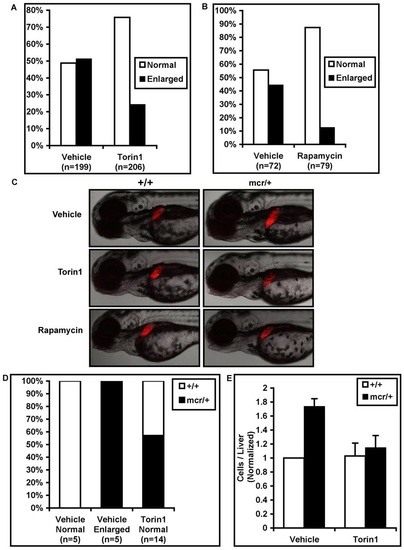
mTORC1 inhibition rescues liver hyperplasia in heterozygous apcmcr/+ zebrafish. Lfabp:rfp zebrafish, which express liver-specific RFP, were mated with apcmcr/+ zebrafish. (A) Resulting progeny (expected 50% apc+/+, 50% apcmcr/+) were treated with vehicle or Torin1 and the percentage of fish with normal or enlarged livers at 3-4 dpf was recorded. Approximately 50% of vehicle-treated fish had enlarged livers, as described previously (Goessling et al., 2008). Torin1 reduced the percentage of fish with enlarged livers. (B) Rapamycin similarly rescued liver enlargement. (C) Representative pictures showing liver enlargement in vehicle-treated heterozygous apcmcr/+ zebrafish but not in Torin1- or rapamycin-treated heterozygotes. (D) Liver size correlated closely with genotype in vehicle-treated embryos, as described previously (Goessling et al., 2008), but heterozygous apcmcr/+ embryos accounted for approximately half of Torin1-treated embryos with normal-size livers, confirming that Torin1 reduces liver size in heterozygous apcmcr/+ embryos. (E) The number of RFP-positive cells per embryo was measured by flow cytometry. Vehicle-treated apcmcr/+ zebrafish had ~75% more hepatocytes than vehicle-treated wild-type fish, and this was rescued by Torin1 treatment.
|

